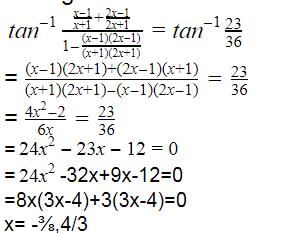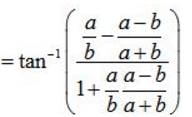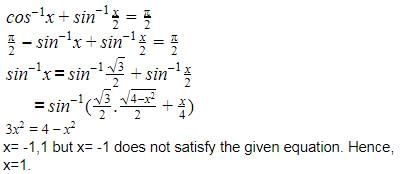Test: Inverse Trigonometry- 2 - JEE MCQ
Test Description
25 Questions MCQ Test - Test: Inverse Trigonometry- 2
Test: Inverse Trigonometry- 2 for JEE 2025 is part of JEE preparation. The Test: Inverse Trigonometry- 2 questions and answers have been prepared
according to the JEE exam syllabus.The Test: Inverse Trigonometry- 2 MCQs are made for JEE 2025 Exam.
Find important definitions, questions, notes, meanings, examples, exercises, MCQs and online tests for Test: Inverse Trigonometry- 2 below.
Solutions of Test: Inverse Trigonometry- 2 questions in English are available as part of our course for JEE & Test: Inverse Trigonometry- 2 solutions in
Hindi for JEE course.
Download more important topics, notes, lectures and mock test series for JEE Exam by signing up for free. Attempt Test: Inverse Trigonometry- 2 | 25 questions in 25 minutes | Mock test for JEE preparation | Free important questions MCQ to study for JEE Exam | Download free PDF with solutions
Detailed Solution for Test: Inverse Trigonometry- 2 - Question 1
Detailed Solution for Test: Inverse Trigonometry- 2 - Question 2
Detailed Solution for Test: Inverse Trigonometry- 2 - Question 3
Detailed Solution for Test: Inverse Trigonometry- 2 - Question 4
Detailed Solution for Test: Inverse Trigonometry- 2 - Question 5
Detailed Solution for Test: Inverse Trigonometry- 2 - Question 6
Detailed Solution for Test: Inverse Trigonometry- 2 - Question 7
Detailed Solution for Test: Inverse Trigonometry- 2 - Question 8
Detailed Solution for Test: Inverse Trigonometry- 2 - Question 9
Detailed Solution for Test: Inverse Trigonometry- 2 - Question 10
Detailed Solution for Test: Inverse Trigonometry- 2 - Question 11
Detailed Solution for Test: Inverse Trigonometry- 2 - Question 12
Detailed Solution for Test: Inverse Trigonometry- 2 - Question 13
Detailed Solution for Test: Inverse Trigonometry- 2 - Question 14
Detailed Solution for Test: Inverse Trigonometry- 2 - Question 15
Detailed Solution for Test: Inverse Trigonometry- 2 - Question 16
Detailed Solution for Test: Inverse Trigonometry- 2 - Question 17
Detailed Solution for Test: Inverse Trigonometry- 2 - Question 18
Detailed Solution for Test: Inverse Trigonometry- 2 - Question 19
Detailed Solution for Test: Inverse Trigonometry- 2 - Question 20
Detailed Solution for Test: Inverse Trigonometry- 2 - Question 21
Detailed Solution for Test: Inverse Trigonometry- 2 - Question 22
Detailed Solution for Test: Inverse Trigonometry- 2 - Question 23
Detailed Solution for Test: Inverse Trigonometry- 2 - Question 24
Test: Inverse Trigonometry- 2 - Question 25
If and x + y + z = xyz, then a value of tan−1x+tan−1y+tan−1z is
Detailed Solution for Test: Inverse Trigonometry- 2 - Question 25
Information about Test: Inverse Trigonometry- 2 Page
In this test you can find the Exam questions for Test: Inverse Trigonometry- 2 solved & explained in the simplest way possible.
Besides giving Questions and answers for Test: Inverse Trigonometry- 2, EduRev gives you an ample number of Online tests for practice
Download as PDF



 is equal to
is equal to 







 is equal to
is equal to 






 is (a, b > 0)
is (a, b > 0)



 is equal to
is equal to 
 , now if θ = tan-1x ⇒ x = tan θ ⇒ sin 2θ =
, now if θ = tan-1x ⇒ x = tan θ ⇒ sin 2θ = 



















